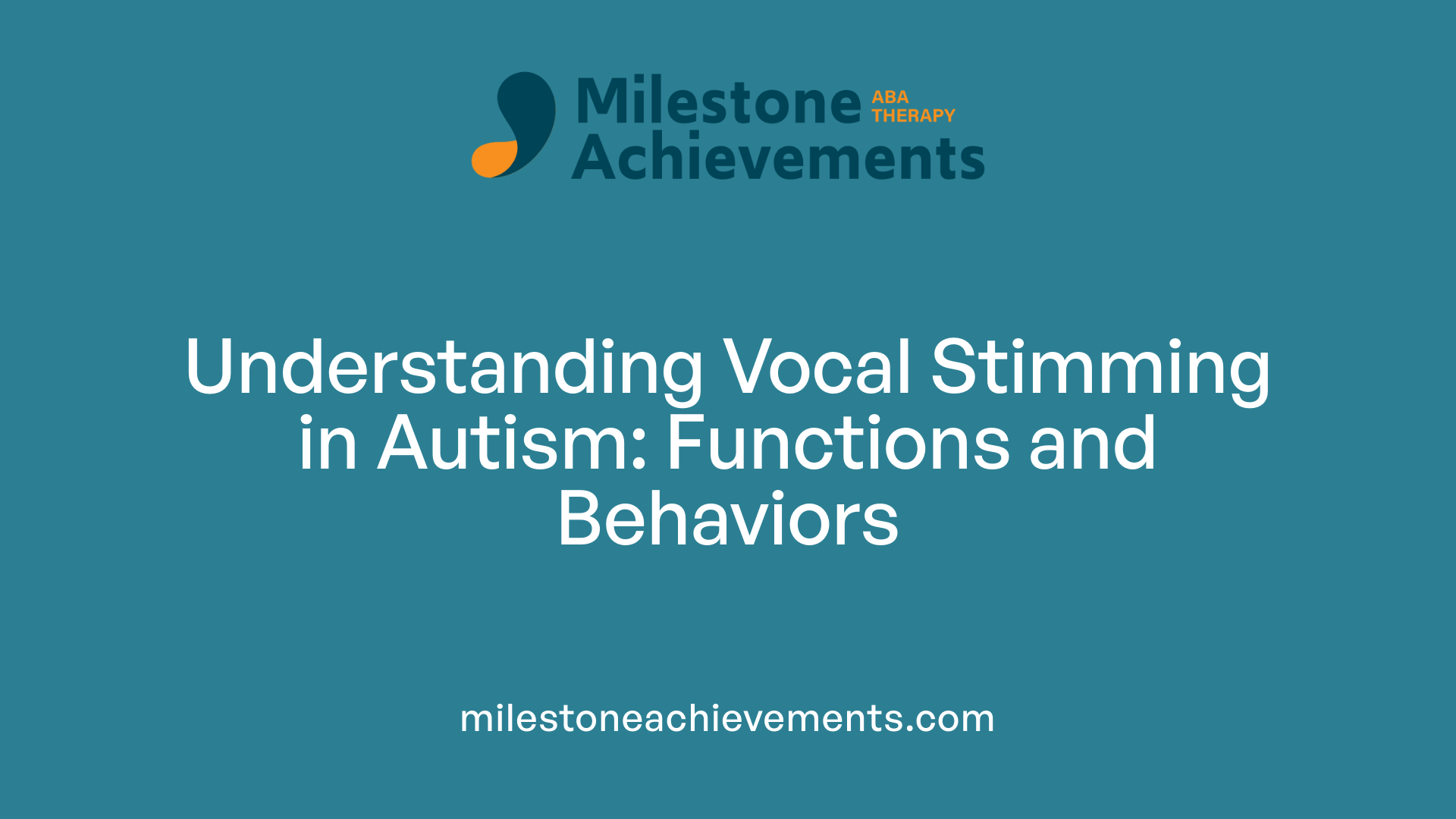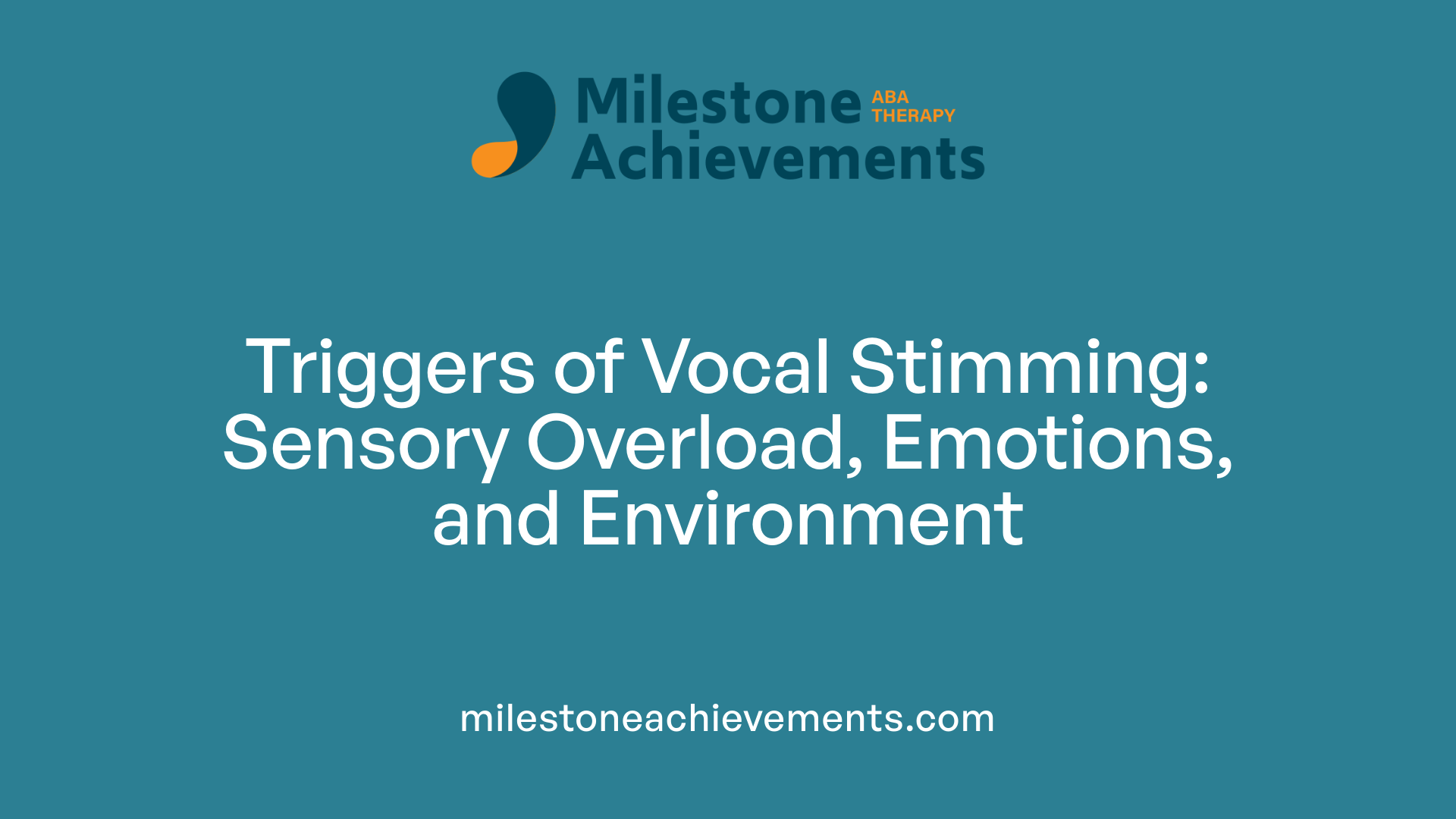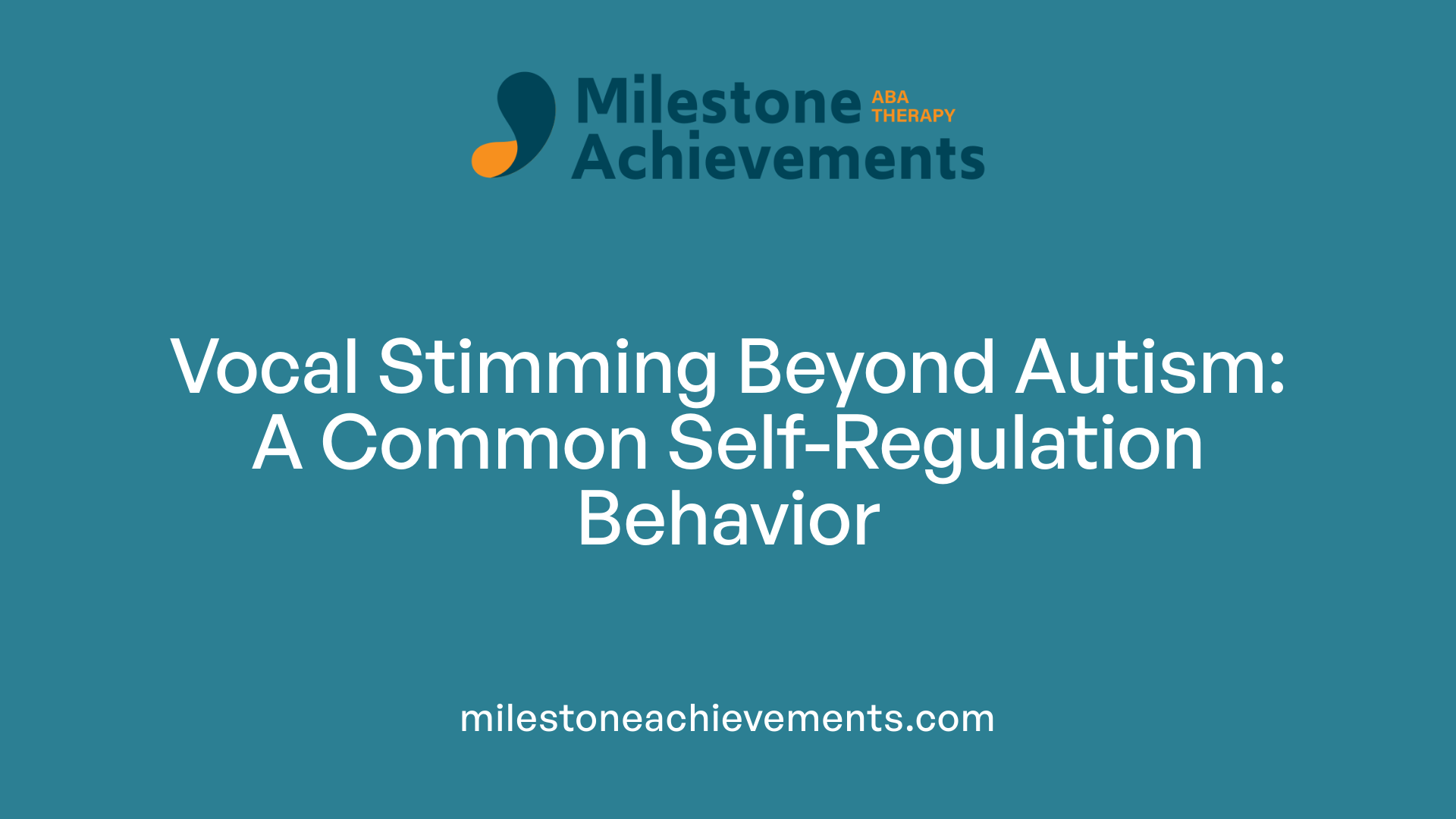
Vocal Stimming In Autism
Understanding Vocal Stimming in Autism: Functions, Behaviors, and Support
A Deep Dive into Vocal Stimming Behaviors in Autism
Vocal stimming is a common behavioural phenomenon among individuals with autism spectrum disorder. It involves the repetition of sounds, words, or phrases using the mouth, vocal cords, and sometimes the ears, serving various functions related to emotional and sensory regulation. This article explores the nature of vocal stimming, its causes and triggers, typical behaviors, and ways to support individuals engaging in these behaviors. By understanding vocal stimming, caregivers, teachers, and clinicians can foster a more accepting environment that recognizes its beneficial role in self-regulation and communication.
What is Vocal Stimming in Autism?

What is vocal stimming in autism?
Vocal stimming in autism encompasses repetitive sounds and vocal behaviors that individuals use to self-regulate and communicate their internal states. This includes actions like humming, squealing, shouting, babbling, or repeating words and phrases, often called echolalia.
These behaviors serve various functions. Many autistic individuals use vocal stimming to soothe themselves or to manage sensory overload. It can also be a way to express excitement, joy, or other emotions, even in non-verbal children.
How does vocal stimming involve the mouth, lips, vocal cords, and ears?
Vocal stimming involves the mouth, lips, and vocal cords directly, as these are the primary organs involved in producing sounds. For example, an individual might hum, whistle, or produce high-pitched squeals using their vocal cords. Some may also create auditory feedback by covering or tapping near their ears to enhance sound perception.
Through these behaviors, they often generate rhythmic or repetitive noises that provide sensory input, helping them feel more grounded.
What functions does vocal stimming serve?
The main reasons for vocal stimming include:
- Self-regulation: Managing emotional distress or sensory overload.
- Emotional expression: Conveying feelings like excitement or frustration.
- Sensory stimulation: Providing auditory input that feels pleasurable or soothing.
- Focus and concentration: Particularly in individuals with ADHD, vocal stimming may help improve attention.
These behaviors are natural and often beneficial, allowing autistic individuals to cope with complex environments and internal sensations, fostering emotional well-being.
Causes and Triggers of Vocal Stimming

What are common triggers of vocal stimming?
Vocal stimming is often a way for individuals, especially those with autism or ADHD, to manage overwhelming sensory input or emotional states. Common triggers include sensory overload caused by loud noises, bright lights, or strong smells. These stimuli can become overwhelming, leading individuals to produce vocal sounds such as humming, shrieking, or repeating words as a form of self-regulation.
Emotional states also play a significant role. Feelings of stress, anxiety, excitement, or intense mood swings can prompt vocal behaviors. For example, a child might start humming loudly when anxious or squealing with joy when excited. These vocalizations act as a coping mechanism or a form of self-soothing, helping to manage intense emotions.
Boredom or fatigue in unfamiliar or unpredictable environments can also trigger vocal stimming. When a person feels bored or tired, especially when routines are disrupted or environments are overstimulating, they might produce repetitive sounds or noises to comfort themselves or fill silence.
Seeking additional sensory input or expressing feelings like happiness or frustration are other reasons behind vocal stimming. It can be a way to communicate internal states or needs when verbal skills are still developing.
Overall, vocal stimming serves as an adaptive behavior to handle sensory overload and emotional distress, providing relief and a sense of control in challenging situations.
Types and Examples of Vocal Stimming Behaviors

What are examples of vocal stimming behaviors?
Vocal stimming includes a variety of repetitive sounds and vocalizations that individuals may produce to self-regulate, express emotions, or seek sensory input. Common examples encompass humming, which can be soothing or pleasurable, and repeating words or phrases, often drawn from media like movies or TV shows. Some individuals may produce squealing, shrieking, or high-pitched noises that serve as sensory stimulation or emotional release.
Additional behaviors include groaning, sighing, or grunting, which can help manage anxiety or sensory overload. Vocalizations such as shouting, singing, or whispering are also typical forms of vocal stimming. Throat-clearing and repetitive babbling are common, especially among children with autism or those who are less verbal.
Imitating environmental sounds or animal noises, similar to mimicking a siren or a bird’s call, is another form of vocal stimming. These sounds often provide a form of auditory feedback that helps individuals maintain focus or calm down in overwhelming situations.
Repetitive vocalizations may also function as a way to express excitement or happiness, sometimes called 'happy stimming.' For instance, an autistic person might repeatedly say a favorite phrase or sing a snippet of a song. These behaviors are beneficial for emotional regulation, sensory pleasure, and self-soothing, especially in environments that feel overstimulating.
While vocal stimming is most common in autism, it can also be seen in individuals with ADHD or other neurodivergent conditions. Understanding and accepting these behaviors as part of an individual’s coping strategy can foster a more supportive environment.
In summary, vocal stimming behaviors can include:
| Behavior | Description | Typically Associated With |
|---|---|---|
| Humming | Making melodic or repetitive sounds with the mouth | Sensory regulation, calming |
| Repeating media phrases | Echoing lines from movies, TV, or songs | Emotional expression, engagement |
| Squealing or shrieking | High-pitched noises for stimulation | Excitement, overstimulation |
| Throat clearing or grunting | Repetitive oral sounds | Anxiety, sensory seeking |
| Imitating sounds | Mimicking environmental or animal sounds | Sensory input, focus |
Vocal stimming is a natural aspect of neurodivergent behaviors and can serve important functions in emotional and sensory regulation.
Vocal Stimming in Autism and Related Conditions

Is vocal stimming unique to autism or related conditions?
Vocal stimming is not exclusive to autism; it is a behavior observed in individuals with various developmental conditions, including ADHD, and can also be seen in typical children.
Many people engage in vocal stimming behaviors such as humming, repeating words or phrases, singing, squealing, or mimicking sounds. These actions often serve practical functions like self-soothing, sensory regulation, or emotional expression.
In autism, vocal stimming helps manage sensory overload, reduce anxiety, and foster self-regulation. However, its presence in non-autistic individuals indicates that it is a natural and functional behavior beyond neurodivergence.
Support strategies focus on understanding the purpose behind vocal stimming, establishing safe outlets, and teaching alternative behaviors when necessary. This might involve using calming tools, developing communication skills, or creating structured routines.
Most importantly, vocal stimming is a normal behavior that can be helpful and positive. Instead of aiming to eliminate it, caregivers and therapists often work to ensure it does not interfere with daily life or cause harm, emphasizing acceptance and support for individual needs.
Ultimately, vocal stimming spans across different populations and is an important aspect of emotional and sensory regulation for many individuals, regardless of whether they are on the autism spectrum.
Persistence and Long-Term Outlook of Vocal Stimming
Does vocal stimming related to autism go away over time?
Vocal stimming connected to autism often remains a part of an individual's behavioral repertoire throughout their life. This behavior frequently serves vital functions, including helping with self-regulation, emotional expression, and managing sensory overload.
While some individuals might show a reduction in vocal stimming behaviors over time—especially as they develop, mature, and gain access to supportive interventions—it usually does not disappear entirely. Instead, the nature of vocal stimming may evolve, becoming less frequent or more controlled depending on the environment and individual circumstances.
Supportive strategies can influence the persistence or management of vocal stimming. Establishing predictable routines, encouraging alternative ways to communicate, and providing sensory outlets such as fidget toys or rhythmic activities can help mitigate disruptive behaviors.
Importantly, vocal stimming is generally a beneficial and natural behavior. It often continues into adulthood, with the behavior sometimes becoming a more conscious choice rather than an involuntary response. Recognizing this, caregivers and professionals emphasize acceptance while also supporting ways to manage behaviors that interfere with daily life.
In summary, vocal stimming in autism typically persists across lifespan, but its expression and impact can be positively managed through tailored interventions. Understanding its enduring role helps foster acceptance and develops more effective support strategies.
Supporting and Managing Vocal Stimming Behaviors
Understanding the function of vocal stimming
Vocal stimming serves many purposes for individuals, especially those with autism or ADHD. It often acts as a way to self-soothe, self-regulate sensory input, express emotions, or enjoy sensory feedback. For example, a child may hum, repeat phrases, or mimic environmental sounds to relieve anxiety or manage sensory overload.
Recognizing the function behind vocal stimming is essential. It helps caregivers and professionals provide appropriate support and develop strategies that address the root need rather than just stopping the behavior.
Creating safe environments and designated spaces
One effective management approach is to create safe, sensory-friendly environments. Providing designated spaces where individuals can freely stim helps them feel accepted and reduces the likelihood of disruptive behavior elsewhere.
Using sensory tools like noise-canceling headphones, fidget toys, or calming visual stimuli can also support self-regulation. These tools offer alternative outlets for sensory input, reducing the urge for disruptive vocalizations.
Teaching social and self-regulation skills
Educating individuals on appropriate times and places for vocal stimming fosters better self-regulation. Using social stories or visual cues can help communicate when vocal stimming is acceptable, such as during play or quiet time.
Teaching coping and social skills, including mindfulness, deep breathing, or grounding techniques, equips individuals to manage triggers that often lead to excessive vocal stimming.
Replacing disruptive behaviors with supportive alternatives
When vocal stimming becomes disruptive or dangerous, substituting it with less intrusive activities is beneficial. For example, humming softly, singing quietly, or doodling can fulfill the same sensory or emotional needs.
Engaging in rhythmic activities, such as clapping or tapping, or using sensory toys like stress balls, can also serve as healthy alternatives. These strategies help maintain emotional well-being while minimizing disruptions.
Professional support and therapy options
Consulting with specialists such as occupational therapists, speech therapists, or behavior analysts can provide personalized interventions. These professionals can assist in developing behavior plans that incorporate functional communication training, sensory integration techniques, and strategies to replace harmful vocal stims.
Additionally, therapy sessions can teach communication skills that help children and adults express their needs verbally, reducing reliance on vocal stimming as a communication method.
Understanding and supporting vocal stimming behaviors through these approaches promotes acceptance and helps individuals build strategies for self-regulation, social integration, and emotional well-being. Recognizing that stimming is a natural part of neurodiversity encourages inclusive environments where everyone can thrive.
Normal Versus Concerning Vocal Stimming and Ethical Considerations

When is vocal stimming considered normal versus concerning?
Vocal stimming often plays a positive role in helping individuals, especially those with autism or ADHD, manage their emotions, sensory input, and focus. It involves making sounds such as humming, squealing, repeating words, or mimicking environmental noises. In general, such behaviors are considered normal when they function as self-soothing or expressive tools that do not disrupt daily life or cause harm.
Normal vocal stimming typically occurs without interfering significantly with social interactions, learning, or safety. For example, a child humming quietly while concentrating or giggling while repeating a favorite phrase is usually viewed as a natural part of their self-regulation.
However, vocal stimming becomes concerning when it escalates to excessive noise, becomes persistent or loud, or interferes with daily activities and social participation. Behavior that causes distress to the individual or others, leads to self-injury, or impairs communication is often seen as problematic. For example, frequent shouting, shrieking in public, or repetitive vocalizations that isolate a person from peers suggest an underlying issue that may require support.
It is important to note that while suppression of vocal stimming should not be automatic, understanding its purpose helps determine whether intervention is necessary. Support strategies focus on creating safe outlets rather than forcing complete elimination, which can cause emotional distress or frustration. Recognizing when vocal stimming supports well-being versus when it becomes disruptive guides caregivers and professionals to adapt approaches accordingly.
Ultimately, the distinction between normal and concerning vocal stimming depends on its impact on an individual’s comfort, safety, and social engagement. Consulting with healthcare or behavioral professionals can help clarify these boundaries and establish supportive routines. Respect for neurodiversity and acceptance underscores the importance of not stigmatizing natural behaviors but instead fostering understanding and safe regulation.
What signs indicate vocal stimming is problematic?
Signs that vocal stimming is problematic include behaviors that are loud or persistent to the point of disturbing others, causing emotional or physical harm, or leading to social exclusion. When vocal stim behaviors interfere with learning environments, family interactions, or community participation, they may warrant intervention. Behaviors that cause the individual distress, such as self-injury, chipping away at their confidence, or creating unsafe situations, are also concerning.
Why is acceptance and support important?
Supporting vocal stimming behaviors fosters emotional well-being, self-acceptance, and social inclusion. Instead of attempting to suppress such behaviors, understanding their function allows caregivers to implement strategies that respect personal needs while promoting safe and appropriate expressions. Techniques like teaching alternative behaviors, establishing routines, and creating safe spaces help individuals feel understood and supported.
Caregivers and professionals should aim to balance support with gentle guidance, encouraging communication and self-regulation skills. This approach reduces stigma and promotes a positive environment that values neurodiversity and individual differences.
| Aspect | Normal Behavior | Concerning Behavior | Strategies for Support |
|---|---|---|---|
| Impact on daily life | Does not interfere significantly | Disrupts routines, social interactions | Creating safe spaces, routine modifications |
| Loudness and persistence | Occasional and moderate | Persistent, loud, or aggressive | Teaching alternative behaviors |
| Effect on others | Well-tolerated | Causes distress or exclusion | Education and awareness programs |
| Self-harm or injury | Not present | Present | Medical and behavioral intervention |
Understanding and supporting vocal stimming helps ensure the well-being of neurodivergent individuals, emphasizing acceptance and practical strategies over suppression.
Embracing and Supporting Vocal Stimming in Autism
Vocal stimming is a natural and functional behavior that plays a vital role in the emotional and sensory regulation of many individuals with autism. Recognizing its purpose and supporting positive management strategies can help promote well-being and social inclusion. It is important to differentiate between behaviors that are benign and those that might require intervention, always prioritizing the individual's comfort and safety. Embracing neurodiversity includes accepting behaviors like vocal stimming, and fostering environments where autistic individuals can express themselves freely and with dignity.
References
- Vocal Stimming in Autism - Exceptional Individuals
- Vocal Stimming in Autism: Causes and Management
- Understanding Vocal Stimming in ADHD and Autism - Verywell Mind
- Vocal Stimming in Autism: What Parents Need to Know - Blue ABA
- What is Vocal Stimming in children with autism, and what causes it?
- Stimming and autism - Leicestershire Partnership NHS Trust
- Stimming and Autism: Are They Related? - WebMD
- Reducing Vocal Stimming and Scripting in Children with Autism
- Vocal Stimming: What It Is and What Types There Are


Partner with us on your child's journey
Milestone Achievements offers evidence-based ABA therapy to help children with autism reach their full potential. Together we’ll set meaningful goals and celebrate progress every step of the way.
Start ABA Services Today


